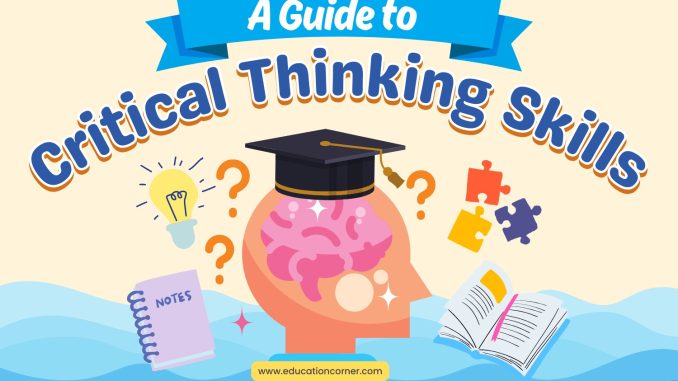
Critical thinking has become one of the most valuable skills in today’s fast-paced and complex world. It is the ability to analyze information, question assumptions, and evaluate evidence before drawing conclusions. In business, education, and everyday life, critical thinking helps individuals navigate uncertainty, make informed decisions, and solve problems creatively. Yet, while the term is often used, the process of developing critical thinking skills is far from automatic. It requires practice, reflection, and environments that encourage curiosity rather than rote acceptance of information.
At its core, critical thinking is about moving beyond surface-level understanding. It challenges individuals to look deeper, asking not only what something means but why it matters, how reliable it is, and what implications it might carry. In a business setting, this can mean the difference between accepting a flattering sales report at face value and questioning whether the numbers truly reflect long-term performance. A leader who thinks critically will not simply celebrate short-term gains but will also consider the broader context, potential risks, and underlying trends. This kind of analysis ensures that decisions are grounded in reality rather than wishful thinking or incomplete information.
Developing critical thinking begins with cultivating curiosity. People who are curious naturally ask questions, explore alternatives, and resist taking things at face value. In educational environments, students who are encouraged to question rather than memorize develop stronger reasoning skills. Similarly, in the workplace, teams that foster open dialogue and debate tend to arrive at more thoughtful solutions than those where employees are expected to agree without challenge. A culture that rewards curiosity helps individuals practice analyzing problems from multiple angles, a habit that becomes second nature over time.
Reflection is another key element in developing critical thinking. Learning from experience means not only acknowledging successes but also examining failures with an eye toward understanding why things unfolded the way they did. For example, if a project falls short of expectations, critical thinking encourages professionals to go beyond simple blame and instead consider what assumptions were made, what data was overlooked, and what could be done differently in the future. This type of reflective practice deepens awareness and sharpens judgment, ensuring that lessons are applied constructively rather than ignored.
Exposure to diverse perspectives also strengthens critical thinking. When individuals interact with people who have different backgrounds, experiences, and viewpoints, they are forced to reexamine their own assumptions. A business team developing a new product, for instance, might approach the design from a technical perspective, but input from marketing, customer service, and even end-users can reveal blind spots that would otherwise go unnoticed. Engaging with a variety of perspectives not only broadens understanding but also challenges individuals to weigh competing ideas, evaluate evidence, and reach more balanced conclusions. This is why diverse teams often produce more innovative and effective outcomes.
The ability to distinguish between fact and opinion is another critical component. In an era saturated with information, from news headlines to social media commentary, the ability to critically evaluate sources has become essential. Not all information carries equal weight, and critical thinkers learn to differentiate between credible evidence and speculation. In business, this might involve scrutinizing the validity of market research or questioning whether a new trend represents a lasting shift or a passing fad. By carefully analyzing the reliability of information, critical thinkers avoid being swayed by hype or incomplete data, grounding their decisions in evidence rather than assumptions.
Communication plays a significant role in developing critical thinking skills as well. Articulating one’s reasoning to others requires clarity of thought, and engaging in constructive debate pushes individuals to refine their ideas. A manager presenting a strategy to their team, for example, must be prepared to explain not just the plan itself but also the rationale behind it, including how alternatives were considered and why this approach makes the most sense. In turn, listening to questions and challenges from colleagues helps reveal gaps in reasoning and strengthens the overall argument. This exchange of ideas creates a dynamic environment where critical thinking flourishes.
Technology has introduced both opportunities and challenges for critical thinking. On one hand, access to vast amounts of information allows learners and professionals to explore topics in unprecedented depth. On the other, the sheer volume of information can be overwhelming, and not all of it is accurate. Developing critical thinking in this context means honing digital literacy—the ability to navigate online content, assess credibility, and synthesize information from multiple sources. In practice, this might mean a professional carefully comparing industry reports from different organizations before making a strategic recommendation, rather than relying on the first article that appears in a search.
Ultimately, developing critical thinking skills is less about finding the right answer and more about refining the process of reaching an answer. It is about cultivating habits of inquiry, reflection, and analysis that can be applied across contexts. A professional who has developed strong critical thinking skills is not easily swayed by groupthink, persuasive rhetoric, or superficial data. Instead, they approach challenges with a balanced mindset, open to new ideas but cautious of unexamined assumptions. This mindset is particularly valuable in leadership, where the consequences of decisions ripple through entire organizations.
The process of building these skills takes time and intentional practice, but the rewards are profound. Critical thinking equips individuals to navigate ambiguity with confidence, adapt to change with agility, and approach complex challenges with resilience. For organizations, investing in the development of these skills among employees pays dividends in the form of better decisions, more innovative solutions, and stronger collaboration. For individuals, it enhances not only professional performance but also personal growth, shaping a mindset that is curious, reflective, and thoughtful. In a world where information is abundant but wisdom is rare, critical thinking remains one of the most important skills to cultivate for lasting success.